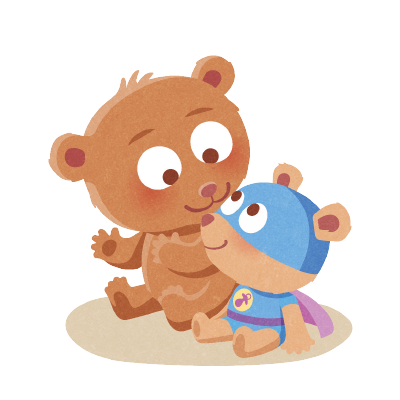Your baby is now six months old – for many parents this feels like a milestone. And it is! Your child has changed remarkably since their birth and the little tadpole has become a real person. And this little personality will become increasingly noticeable: with squeaking and babbling, and soon they will also try to imitate very specific sounds.

Most babies can now sit relatively stably on their own and many are able to turn from their tummy to their back and back again. Some lean up and lift their legs – as if they were doing fitness exercises. And in a certain sense, they are: all these movements are aimed at strengthening the muscles and making more and more movements possible. You may notice your child walking on all fours and even trying to crawl for the first time. But – as with everything – not all babies are ready and some remain lying or sitting exactly where you put them. There are various reasons for this: Some children are not yet physically ready, others are still afraid of this new freedom – moving around without their parents. More movement and independence often means more emotions and a greater need for closeness.
Their fine motor skills are also constantly improving: the baby can now grasp objects more purposefully and pull them towards them, even when lying down. And above all, they can let go of them more easily.
If your baby is already used to complementary feeding, you can now try out different recipes and get your baby used to different flavours. And “get used to” really is the right way of putting it: even if the child initially rejects a flavour, you shouldn’t give up straight away. Children’s taste buds are very sensitive. They quickly find something unappealing and have to “get to know” new variations first. But of course there are also things that the little ones categorically reject and you should respect that.
It is quite possible that your baby is now starting to teethe or even that their first tooth has suddenly appeared. The lower, central incisors are usually the first to come in. Signs include increased restlessness and crying (especially at night), increased temperature and sometimes red, swollen gums or reddened cheeks. Some babies react with diarrhoea or a red nappy area. Increased salivation and “chewing” on their fingers are also usually signs that something is happening in the mouth. If you have the feeling that your baby is teething, you can give them something to bite on: a teething ring (can also be cooled, but only in the fridge, never in the freezer) or a clean, wet rag. A gentle gum massage sometimes also provides relief.

To make it easier for your baby to fall asleep at night, a routine can be helpful. Always start at around the same time and always follow the same sequence: this could be a bath, perhaps a gentle baby massage or a cuddly moment, putting on pyjamas, singing to your baby in the already darkened room, followed by the bedtime routine. Over time, they will become familiar with this routine and some babies will find it easier to settle down to sleep. It also gives them a sense of security if the evening always follows a certain routine.